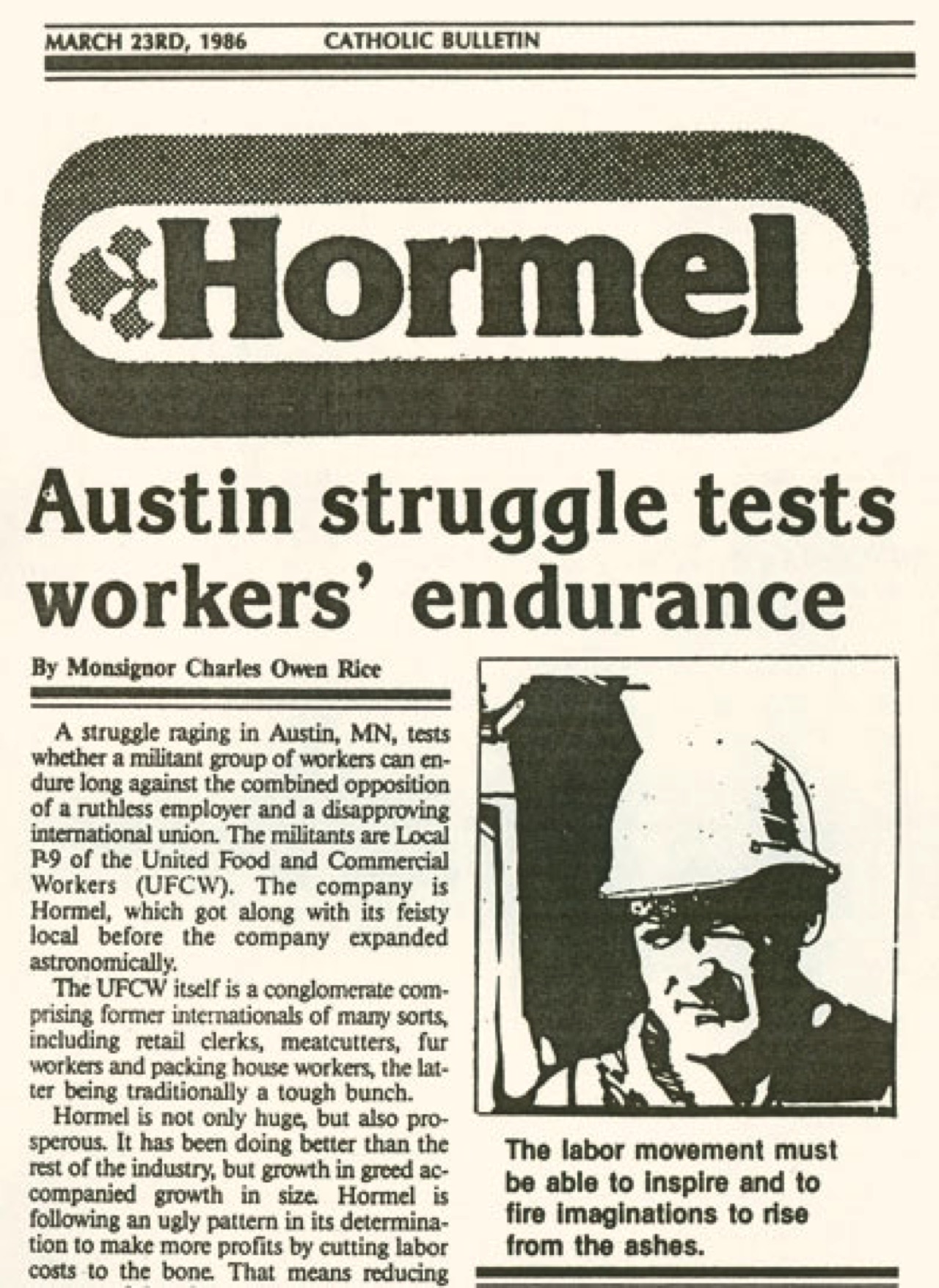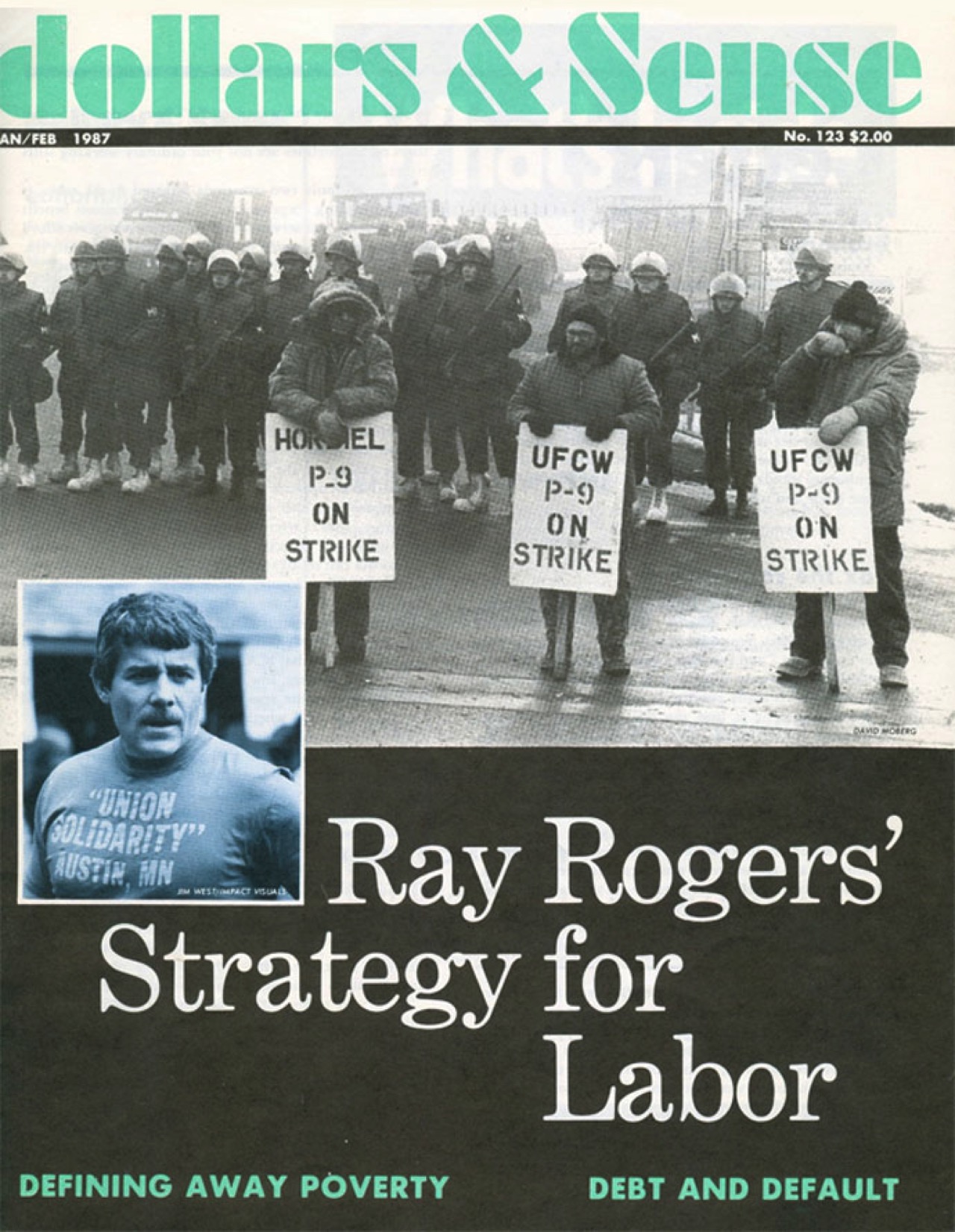The "Corporate Campaign" Strategy
Helping Labor Unions and Public Interest Groups Confront Unbridled Corporate and Political Greed since 1981
Learn More
Helping Labor Unions and Public Interest Groups Confront Unbridled Corporate and Political Greed since 1981
[The text, which is under construction, will describe how this 1,500-member local in Austin, Minnesota, became the most celebrated and most powerful force in organized labor fighting against concessions. It will also describe how their own international union and the national leadership of the AFL-CIO did what the Hormel Co. and its bank, First Bank System; local and state police, and the National Guard could not do -- they prevented a victory that set the labor movement back decades rather than forward decades. Each member of P-9's executive board represented great courage and integrity and the type of leadership the labor movement so badly needs — President Jim Guyette, Vice President Lynn Huston, Financial Secretary Kathy Buck, Business Agent Pete Winkels, and Executive Board members Floyd Lenoch, Carl Pontius, Jim Retterath and John "Skinny" Weis.]
The epic struggle between George A. Hormel & Co., and United Food and Commercial Workers Local P-9 (P stands for Packinghouse) exemplified the best and worst of the forces and players in Corporate America and organized labor. In 1984, Hormel was highly profitable and described by BusinessWeek as "the envy of the industry." Local P-9 represented 1,500 men and women who worked in the company's flagship plant in Austin, Minnesota, a town of about 22,000. They slaughtered hogs and turned them into meat products including Spam.
Killing floors and meat processing and packing plants are horrible environments for anyone to work in. For the animals, these plants are a nightmare. The best one can hope in this industry is humane, carefully regulated treatment of the animals leading up to and during the slaughtering process. For workers in the industry and their small town communities, only a strong union can assure safe working conditions, decent wages and benefits, job security and an environment free of toxic and carcinogenic waste.
Hormel and other companies throughout the industry push workers to operate like machines. Production is never fast enough in the kill and cut assembly lines. Sharp knives, repetitive motions, dangerous machinery, unhealthy working conditions and assembly line speedups lead to astonishing numbers of debilitating injuries. Carpel tunnel, tendonitis, strained and dislocated backs and shoulders, spine and nerve injuries, gashes and mangled and severed hands and fingers are too commonplace. Local P-9 President Jim Guyette, elected in December 1983 said, "The plant is a walking infirmary." The Austin plant had one of the highest injury rates in the industry. In the year before the August, 1985 strike there were more than 200 injuries for every 100 workers in the plant. The national average at the time was 10 per 100. In 1984, one third of the workers in the Austin plant suffered injuries serious enough to cause lost time on the job. Corporate Campaign, inc. (CCI) prepared a special edition of the union's newspaper, The Unionist in May, 1985 entitled "Legacy of Pain: Hormel's Injured Workers in Austin." CCI journalist Hardy Green and photographer Bob Gumpert interviewed and photographed injured workers. Together they vividly portrayed their stories and showed their injuries.
In October 1984, members were hit with a 23% wage cut from $10.69 to $8.25 an hour, or about $100 a week. An arbitrator's ruling six months later put the wage back up to $8.75 but allowed the company to cut benefits deeply, including coverage under the company-carried health insurance plan. These cuts were made retroactive to September 23, 1984. This meant workers who had used the health plan for themselves and family members were immediately in debt to the company. In his booklet The 1985-86 Hormel Meat-Packer Strike in Austin, Minnesota, Fred Halstead stated, "In some cases this amounted to thousands of dollars, in others many hundreds. The company deducted this, chunk by chunk, from the already mangled paychecks."
The wage and benefit cuts came as a total surprise to P-9 members. As a concession in 1978, workers had agreed to loan the company $20 million to help build a new plant. This was to save jobs after the company threatened to close the Austin plant and build a new plant elsewhere. The loan was made possible by placing a large portion of member's incentive pay into an escrow account that would be paid back later. However, during the transition from the old to the new plant, Hormel slashed the number of jobs from 3,000 to 1,500. But what made the wage and benefit cuts even more intolerable, and irreparably damaged the local's relationship with the International was that in 1981 the UFCW negotiated an agreement for Local P-9 that froze wages and mandated a number of other concessions.
Members, at the time, were told that the agreement contained the following clause: "The cost-of-living adjustment which is now in effect will be incorporated into the rates, and there will be no increase or reduction in rates for the balance of the present term of the Agreement and for the 1982-1985 terms of the Agreement."
In selling the contract to its members, UFCW Packinghouse Director Lewie Anderson prepared and distributed a Memorandum of Agreement to P-9 members that included the clause. He reiterated that the company could not reduce the basic wage rate during the contract that wouldn't expire until mid-August 1985. This was a big lie and Anderson and the UFCW knew it. Beginning in 1981, Guyette repeatedly requested to see an actual contract, but was told time and again by UFCW lawyers that it was still being worked on. It would be December of 1984 before he actually got to see it.
Another major thorn in the side of UFCW packinghouse locals was how the UFCW representing unions at Hormel and other companies, was negotiating contracts that provided locals different contract expiration dates. This assured that workers legally could not shut down a company's entire operations. If workers struck at a plant, work would shift to other plants. This greatly diminished the power of the strike in the industry and greatly empowered Hormel and other companies at the expense of the union locals. Workers in the industry were questioning, and rightfully so, in whose interests is the UFCW national leadership working -- the companies or the members? It became painfully clear, it was not the members.
In July 1984, CCI co-founder Ed Allen walked into Ray's office and said "There's a Jim Guyette calling from Minnesota who read about us in BusinessWeek and wants to talk with you."
After Jim explained the mess created by the UFCW and a greedy Hormel, Ray told Guyette he needed to raise a couple of concerns. First he told Jim, "I'm a vegetarian." Jim replied, "That's no problem with us." Ray was preparing Jim for the next question. "Jim, I know a meatpacking plant is where animals are slaughtered and turned into food. But I need to ask if the animals are being treated inhumanely, will the union stand up and fight to protect the animals?" Jim replied, "Yes, we would." That was important because Ray told Jim that Corporate Campaign could not fight for workers who could sit by and allow inhumane treatment of animals. (To be continued)

Catholic Bulletin March 23, 1986
We find some unusual features in this struggle. The UFCW pays strike pay and recognizes the legality of the strike, but it disparages the strikers and their leaders, declaring loudly that their cause is hopeless and their leaders inexperienced and misguided...
An issue has been made of Ray Rogers...who is working for Local P-9. The UFCW leaders disparage him. They also attack and try to ridicule him. They cannot induce or force the local to fire him...
I think the UFCW made a mistake, not only where Rogers is concerned, but with respect to the entire situation. They should have cooperated fully with the tough men and women of Austin, and thus might have struck a spark in its whole organization.
Rogers has the fresh ideas, the courage and the willingness to fight that the labor movement desperately needs. Given the chance, he might become the John L. Lewis of this generation. Without people like him, the entire labor movement will continue its slow decline, which saddens me beyond measure.
The UFCW is proud of being the largest affiliate of the AFL-CIO...But the number of members alone is not the only thing that counts. Do you serve the members to the utmost? Do you make them strong and free, or do you merely preside over a steady deterioration in their financial well-being and self-respect? Better to lose a few tough ones after a brave united struggle than lose credibility...
Ray Rogers is not the only flaming spirit. Local president James Guyette and his executive board stand fast...The labor movement must be able to inspire and to fire imagination to rise from the ashes. Otherwise, it is doomed to innocuousness and and disuse.
I said to the P-9 workers, "I'm going to show you how to run a multi-million dollar campaign without having millions of dollars because the most important resource the local union has is the rank-and-file. We're going to collectively mobilize your knowledge, your skills, your imagination, and your energies. If there is a strike, instead of having hundreds of you stand out there on a picket line being starved into submission, every one of you is going to do a job. If you're a good speaker, or a good organizer, or a good writer, or good working in the office, or good at chopping wood so that people have something to heat their homes with, that's what you're going to do. If we had to pay all of you to do this, it would cost us millions of dollars." (Download Article in .PDF)

Dollars and Sense